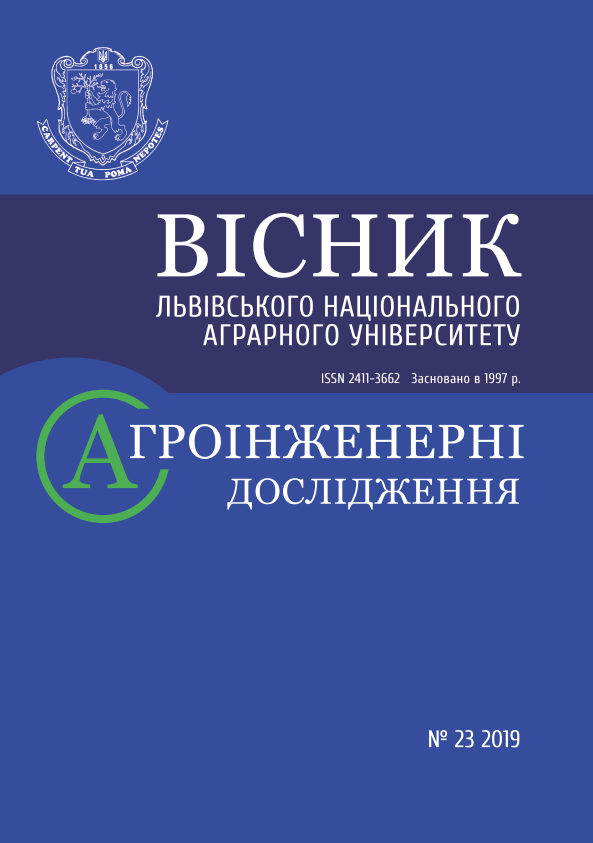RESEARCH OF ELECTRO-GRAVITY SEPARATION OF GRAIN
DOI:
https://doi.org/10.31734/agroengineering2019.23.019Keywords:
grain electrogravitational separation, chamber electrocorona separator, the criterion of division, e mass of a thousand of seeds, impurities, losses, quality of separationAbstract
The article is devoted to substantiation of technological parameters of the process of electrogravitational separation of grain.
The results of studies of the process of electrogravitational separation of wheat, barley and rye grain with using a chamber electrocorona separator are presented in the article. The grain mix was separated in the horizontal plane into three fractions in the electrocorona separator.
The seed mixtures, subjected to separation process, contained high-quality grain, puny, crushed and threshed grains (wastes), parts of spikelets, stems and weed seeds, other impurities.
Separation efficiency was evaluated by determining the mass of thousands of seeds of each separated fraction, the content of impurities in the separated seeds, and the loss of the main crop to the waste. The high voltage of the electric field in the inter-electrode zone of the separator served as a regulated parameter of the process.
As a result of the studies, it has been found that the maximum mass of one thousand seeds is in the seed fraction in the 1 receiver (with a minimum of vertical deviation angle) at electrode voltages within 15…20 kV. The decrease in voltage leads to a decrease of this index and an increase in impurities in the separated grain. The voltage increasing up to 15 kV leads to an increased loss of the main crop to the waste.
Result of the researches demonstrate that the optimum mode of operation of the separator during the separation of winter wheat seeds is achieved at voltages at the corona electrode of U = 14…15 kV; for barley seeds the losses and clogging do not exceed the norm of the voltage at the corona electrode of U = 15 kV; optimum rye separation mode is ensured by the voltage at the corona electrode of U = 13…14 kV.
References
Basov, A. M. (1968). Elektrozernoochistitelnye mashiny. Teoriia, konstruktsii i raschiot. Moskva: Mashinostroenie.
DSTU 7160:2010. (2010). Nasinnia ovochevykh, bashtannykh, kormovykh i priano-aromatychnykh kultur, sortovi ta posivni yakosti. Tekhnichni umovy. Kyiv: Derzhspozhyvstandart Ukrainy.
Kovalyshyn, S. Y., & Shvets, O. P. (2011). Zastosuvannia elektrychnoho polia koronnoho rozriadu pid chas peredposivnoi obrobky nasinnia ozymoho ripaku. MOTROL Motoryzacia i energetyca rolnictwa, 13D, 276–283.
Kovalishin, S. Y., & Shvets, A. P. (2012). Rezultaty issledovaniy protsessa dopolnitelnoy ochistki semian ozimogo rapsa na elektrofriktsionnom separatore. Nauchnyie trudi. Rusenskiy universitet «Angel K'nchev», 51, 56–60.
Paraniuk, V. O., Kovalyshyn, S. I., Melnychuk, V. I., & Shvets, O. P. (2007). Fizychni osnovy tekhnolohii separuvannia nasinnia silskohospodarskykh kultur. Tekhniko-tekhnolohichni aspekty rozvytku ta vyprobuvannia novoi tekhniky i tekhnolohii dlia silskoho hospodarstva Ukraiiny, 10 (24). 77 – 86.
Paraniuk, V. O., Kovalyshyn, S. I., Vorobkevych, V. Iu., & Rivis, Y. F. (1999). Patent Ukraiiny 25302A, MKY A 01 S 1/00/.
Stencel, J. M., Schaefer, J. L., Ban, H., & Neathery, J. K. (1999). United States of America Patent No. 5,938,041.
Berlage, A. G., Bilsland, D. M., Churchill, D. B., & Cooper, T. M. (1990). Electrostatic separation to improve germination of carrot and celery seed. Trans. ASAE, 33(2), 597–600.
Dwari, R. K., & Hanumantha Rao, K. (2006). Tribo-electrostatic behaviour of high ashnon-coking Indian thermal coal. Int. J. Miner. Process. 81, 93–104.
Hemery, Y., Holopainen, U., Lampi, A.-M., Lehtinen, P., Nurmi, T., Piironen, V. … Rouau, X. (2011). Potential of dry fractionation of wheat bran for the development of food ingredients. Part 2: Electrostatic separation of particles. Journal of Cereal Science, 53, 9–18.
Hlavaèova, Z. (2011). Electrical properties of agricultural products. In J. Gliñski, J. Horabik, & J. Lipiec (Eds), Encyclopedia of Agrophysics. Dordrecht-Heidelberg; London; New York: Springer Press.
Knoll, F. S., & Taylor, J. B. (1984). Advances in Electrostatic Separation. SME Preprint.
Kovalyshyn, S., Dadak, V., & Konyk, S. (2015). Іntensification of the process of preparing of small seed crop mixtures. Acta technologica agriculture. The Scientific Journal for Agricultural Engineering, 4, 108–112.
Kovalyshyn, S., Shvets, O., Grundas, S., & Tys, J. (2013). Use of electro-separation metod for improvement of the utility value of winter rapeseeds. Int. J. Agrophysics, 27, 419–424.
Kovalyshyn, S., & Shvets, O. (2018). Study of efficiency of additional cleaning of rape seeds on the electrofrictional separator. In VI Іnternational Scientific Congress a machinery. Vol. 1/3, June 2018. Proceedings. Vol. 1. Agricultural machines. Research and testing. New machine designs. 25.06 – 28.06.2018 (pp. 13–15). Burgas, Bulgaria.
Manouchehri, H. R., Hanumantha Rao, K., & Forsberg, K. S. E. (2000a). Review of electrical separation methods. Part 1: Fundamental aspects. Miner. Metall. Process. 17 (1), 23–36.
Manouchehri, H. R., Hanumantha Rao, K., & Forsberg, K. S. E. (2000b). Review of electrical separation methods. Part 2: Practical consideration. Miner. Metall. Process. 17 (3), 139–166.
Mazumder, M. K., Tennal, K. B., Lindquist, D. A. (1995). Triboelectric separation of coal from mineral impurities. In Electrostatic society of America 1995. Annual Meeting proceedings (pp. 59–70). Laplacian press, Morgan Hill, CA.
Messal, S., Corondan, R., Chetan, I., Ouiddir, R., Medles, K., & Dascalescu, L. (2015). Electrostatic separator for micronized mixtures of metals and plastics originating from waste electric and electronic equipment. Journal of Physics, 646, 1–4.
Pandya, T. S., Srinivasan, R., & Thompson, C. P. (2013). Fiber Separation for Ground Corn Flour Using an Electrostatic Method. Cereal Chemistry, 90 (6). 535–539.


